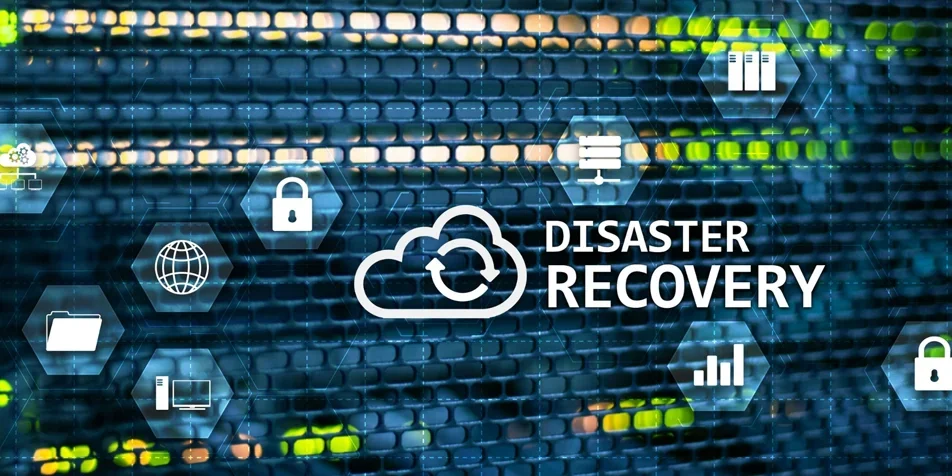1.
What is Disaster Recovery as a Service (DRaaS)?
Human errors and natural disasters always pose significant risks to IT infrastructures. It is necessary to take precautions and create recovery plans for all possible disaster scenarios. The core of disaster recovery services involves storing data in different locations. Disasters can be natural or human-induced. Events like fires, floods, and earthquakes can negatively affect your IT infrastructure. Disaster recovery focuses on quickly restoring systems using regularly taken backups in such situations.
Any disruption in your systems can cause all your business processes to halt. The goal of disaster recovery services, which follow a pre-prepared plan, is to restore IT infrastructures to their original state in the shortest possible time and with minimal data loss.
2.
What is Cyber Recovery?
Another situation that can negatively impact your digital systems is cyber attacks. Cyber attacks targeting companies cause millions of dollars in losses every year. Despite ongoing investments in cybersecurity, companies must recognize that cybercriminals continuously evolve their methods. You should plan how to handle such situations, acknowledging that you could still be targeted by cyber attacks despite all high-level precautions.
Cyber attacks focus on disrupting systems, seizing or corrupting data. Cyber recovery aims to make systems operational again without data loss following a cyber attack. The key in cyber recovery is to ensure that the backup data used for recovery remains unchanged.
Ransomware and cryptolocker are among the most common methods used by cybercriminals targeting companies. In 2023, the success rate of ransomware attacks increased by a significant 128.17% compared to the previous year. [1]
These attackers, who quickly spread within the infiltrated network, encrypting data and rendering it inaccessible, demand ransom and can cause significant damage to companies. Even if companies agree to pay the ransom, there is no guarantee that the attackers will keep their word. However, with a cyber recovery plan, you can intervene quickly and minimize the damage.
Cyber recovery involves ensuring that the data used for recovery has not been altered and that cyber attackers are completely cut off from the system.
3.
Differences Between Disaster Recovery and Cyber Recovery
Both disaster recovery and cyber recovery are critical components of a company's recovery plan. They both aim to restore computer systems to operational status with minimal data loss and disruption. However, some differences necessitate treating disaster recovery and cyber recovery under separate headings. They differ in terms of the cause of the recovery need, priorities, and methods used.
4.
Source of the Emergency
The primary difference between disaster recovery and cyber recovery lies in the source of the emergency necessitating recovery. Disaster recovery is implemented as a precaution against human and natural disasters. Human-induced disasters can include accidental damage to data integrity, fires, electrical leaks, while natural disasters can include events like earthquakes, landslides, and floods. Cyber recovery, on the other hand, is directly aimed at preventing and mitigating the effects of cyber attacks. The emergency arises from malicious individuals targeting computer systems. The negative impacts of natural disasters vary in scope, but every cyber attack aims to render your network and systems inoperative.
5.
Method Differences
Disaster recovery involves creating backups in data centers located in different locations. Various tools and methods are used for load balancing and reactivating backups. During any disaster, backups in different locations remain safe, and the recovery team can quickly use these backups to restore systems. In cyber recovery, having backups in different locations alone is not sufficient. The backups need to be stored in an immutable format known as AirGap. The process involves monitoring network status, eliminating the effects of cyber attacks, and verifying data integrity. Tasks such as scanning, analyzing, monitoring, and reverting to secure backups post-attack are performed.
6.
Recovery Goals
The goal of disaster recovery is to quickly revert to the nearest backup to restore systems. Data loss is assumed to be limited to the period between the occurrence of the event and the latest backup. In cyber recovery, reverting to the nearest backup alone is not always sufficient. A detailed process must be carried out from the moment the cyber attack is detected. It must be ensured that cyber attackers' access to the network and system is completely terminated. The integrity of the data to be recovered must be confirmed, and it must be verified that it has not been tampered with. Recovery is carried out from the latest unaltered copy.
7.
Importance of Recovery Plans
Recovery plans enable you to take quick action against emergencies and mitigate these adverse events with minimal damage. Emergencies can become a survival challenge for companies. For companies without a recovery plan or backup plan, any disaster or cyber attack can result in all business processes stopping and data being lost. This can lead to a chain reaction of negative impacts, including halted production, lost customers, and extremely high recovery costs, resulting in significant financial losses for the business. Recovery plans help mitigate these worst-case scenarios with minimal damage.
96% of companies with a reliable backup and recovery plan have successfully overcome ransomware attacks. [2] A recovery plan ensures your business continuity, allowing you to serve your customers without interruption and protect your brand value. Recovery plans help you overcome emergencies with minimal cost and in the shortest time possible.
GlassHouse helps companies maintain business continuity securely in the digital environment with its disaster recovery and cyber recovery solutions. You can explore these products for your company's cybersecurity and disaster recovery solutions, ensuring your data is always secure by preparing your plan in advance.
[1] https://securityaffairs.com/157759/reports/ransomware-attacks-2023-report.html [2] https://www.forbes.com/sites/forbestechcouncil/2020/07/03/why-cyber-resilience-is-a-crucial-component-of-this-new-stay-at-home-world/













